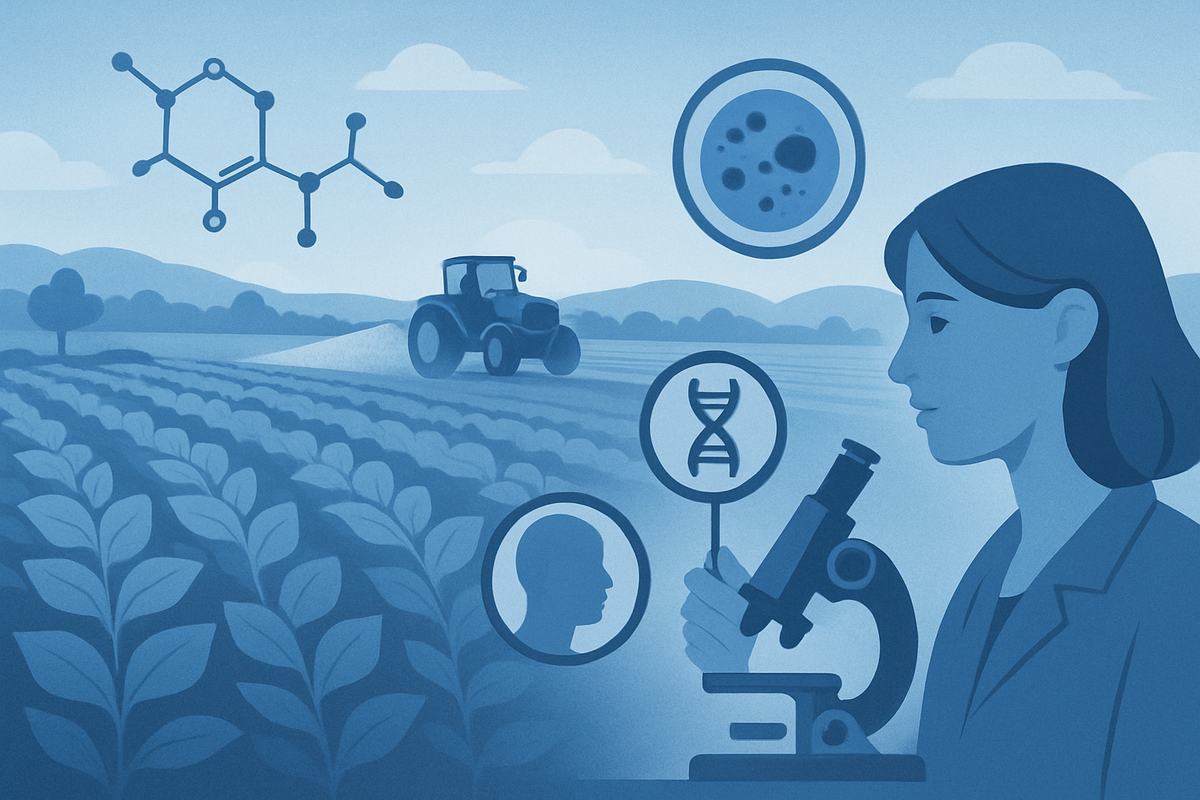How Glyphosate-Damaged Crops Drive Chronic Disease and SOD Sciences can Resolve it

Modern farming has come to rely heavily on herbicides and fungicides, with glyphosate, marketed as Roundup, being the most widely used. The prevailing narrative is that the danger lies in chemical residues left on food, but the deeper and more insidious problem is what these chemicals do to the plants themselves.
Glyphosate does not merely linger on the surface of crops; it disrupts their fundamental biology. By inducing chronic oxidative stress inside the plant, glyphosate and other pesticides cause crops to accumulate harmful oxidation products. These compounds persist into the human diet and, for individuals carrying genetic vulnerabilities, act like poison. Instead of nourishing the body, they trigger inflammation, mitochondrial dysfunction, and ultimately chronic disease. With over half of the U.S. food supply treated with glyphosate and millions of Americans genetically predisposed to oxidative imbalance, this is a silent public health crisis hiding in plain sight.
This is where SOD Sciences Inc. plays a critical role. The company is pioneering low-cost, direct-to-consumer saliva testing that can identify people who carry genetic variants, such as SOD2 rs4880, GPX1 rs1050450, or APOE4, that leave them especially vulnerable to oxidative imbalance. For these individuals, eating oxidatively stressed crops accelerates inflammation, mitochondrial dysfunction, and disease. At the same time, SOD Sciences is developing a proprietary, patent-pending agricultural solution that reduces oxidative stress in plants after glyphosate exposure, protecting crops at their source and, in turn, the people who consume them. With millions of Americans at genetic risk and much of the food supply exposed, the need for this dual approach has never been greater.
How Herbicides and Fungicides Disrupt Plant Biology
Plants maintain a natural balance between reactive oxygen species, or ROS, and their antioxidant defenses. When this balance is disrupted, the plant slips into a state of chronic oxidative stress. Glyphosate is particularly destructive because it blocks the shikimate pathway, a process essential for producing key aromatic amino acids. This blockage leads to metabolic chaos that triggers bursts of ROS within the plant. At the same time, glyphosate depletes glutathione, the plant’s most important antioxidant, and disables the enzymes needed for detoxification. The result is uncontrolled oxidative damage, particularly in chloroplasts where photosynthesis occurs.
Fungicides add another layer of injury. They interfere with mitochondrial respiration, causing electrons to leak and generating excess ROS. They damage cell membranes through lipid peroxidation, destabilizing organelles and leaving cells vulnerable. They also impair photosystem II, a critical component of light capture, which amplifies the plant’s oxidative burden. Over time, these mechanisms leave crops chemically altered, carrying markers of stress such as malondialdehyde, 4-hydroxynonenal, oxidized proteins, and advanced glycation end-products.
What Happens When We Eat Oxidatively Damaged Crops
The problem for human health is not primarily the residue of these chemicals but the oxidized molecules that become part of the plant’s biochemistry. These compounds survive cooking and digestion and reach the intestine in an active form. Once inside the gut, they begin a cascade of damage. Reactive aldehydes bind to the proteins that hold intestinal cells together, weakening the epithelial barrier and creating a leaky gut. Immune receptors recognize oxidized proteins and AGEs as danger signals, activating inflammatory pathways such as NF-κB. At the same time, mitochondrial stress within immune cells primes inflammasomes, which release inflammatory cytokines including IL-1β.
The disruption does not stop there. Oxidation products alter the gut microbiome, suppressing protective bacteria while encouraging pathogenic species. This imbalance increases the leakage of bacterial endotoxins, which further amplify systemic inflammation. What begins as oxidative damage in crops ends as a self-sustaining cycle of gut barrier breakdown, microbial translocation, and widespread inflammation in the human body.
The Genetic “Perfect Storm”
Not everyone responds to this oxidative load in the same way. Many people can mount adequate defenses through their antioxidant systems, but millions are genetically predisposed to fail. The SOD2 rs4880 TT genotype, carried by about thirty-five percent of Americans and as many as eighty-five percent of Asians, reduces the activity of mitochondrial superoxide dismutase by up to forty percent. This leaves the mitochondria unable to clear superoxide radicals effectively. Another twenty percent of Americans carry the TC variant, which further weakens this system.
The GPX1 rs1050450 polymorphism, present in fifteen to twenty-five percent of people, impairs the detoxification of hydrogen peroxide, compounding the problem. Meanwhile, APOE4 carriers, representing about seven percent of the U.S. population, experience lower antioxidant capacity, poor mitochondrial energy function, and higher baseline oxidative stress. These individuals live in a state of low-grade oxidative imbalance from birth. When they consume oxidatively stressed crops, their delicate balance collapses entirely. Glutathione reserves are depleted, mitochondrial dysfunction accelerates, and inflammation becomes chronic and systemic. This biochemical storm directly accelerates the onset of cancer, cardiovascular disease, neurodegeneration, autoimmune conditions, and infertility.
The Scale of the Crisis
The numbers make clear how widespread the risk has become. In the United States, between six and sixteen million people are “super vulnerable,” carrying multiple high-risk variants that amplify oxidative stress geometrically. A broader population of 165 to 198 million people carries at least one risk allele, placing them at elevated danger. On the agricultural side, the scope is equally overwhelming.
More than ninety percent of soybeans, nearly ninety percent of corn, and almost all cotton are sprayed with glyphosate. More than half of all U.S. cropland is exposed to it each year. This means that the majority of the American diet is built upon crops burdened with oxidative damage, a structural problem embedded deep in the food supply.
SOD Sciences’ Proprietary Breakthrough
For years, attempts to mitigate glyphosate’s oxidative impact on crops through foliar treatments have failed. Most degrade too quickly under field conditions or lack the biochemical power to restore the plant’s natural defenses. They cannot meaningfully replenish glutathione, reverse DNA or protein damage, or undo the structural oxidative imbalance glyphosate inflicts. The result is that crops remain chemically altered, carrying forward the oxidative stress that ultimately contributes to human inflammation and disease.
SOD Sciences Inc. has developed a proprietary solution, now under provisional patent protection, that directly addresses this problem. Applied two days after glyphosate, the company’s breakthrough treatment reduces oxidative stress inside the plant, restoring antioxidant balance and lowering the buildup of harmful oxidative byproducts. What makes this so transformative is that the same protective mechanism that shields the plant also safeguards the people who consume it. By lowering the oxidative load of food at its source, this intervention cuts off the cascade of damage before it ever reaches the human gut.
This innovation marks a fundamental departure from speculative fixes and conventional agricultural additives. It represents the first credible, patent-protected method to protect both crops and consumers, closing the loop between agricultural health and human health in a way that has never before been possible.
Personalized Genetic Testing and Early Intervention
The true path forward lies not in patchwork fixes but in precision prevention. SOD Sciences Inc. has developed a direct-to-consumer saliva test that identifies genetic vulnerabilities such as SOD2 rs4880, GPX1 rs1050450, and APOE4. By detecting these variants early, even at birth, individuals can understand their baseline risk before decades of oxidative damage accumulate. This knowledge enables targeted interventions: prioritizing organic and antioxidant-rich diets, supplementing with glutathione precursors and mitochondrial support compounds, and avoiding high-residue crops or environments that add to oxidative stress. Early detection also allows for medical monitoring to catch disease in its earliest stages, when interventions are most effective.
This is personalized medicine at its most powerful. Instead of waiting for chronic diseases to appear and attempting to manage them after the fact, SOD Sciences Inc. offers a way to predict and prevent illness by addressing the root cause of oxidative imbalance. The accessibility and low cost of saliva-based testing remove barriers and make it possible to deploy this approach at a public health scale.
A Public Health Imperative
Crops grown under chronic oxidative stress from glyphosate and fungicides represent one of the most underappreciated drivers of disease in modern society. The damage is not something that can be washed off; it is built into the molecular fabric of the food itself. For genetically vulnerable individuals, who make up more than half of the U.S. population, these foods act as catalysts for inflammation, mitochondrial failure, and chronic illness.
The way forward is clear. By identifying vulnerable individuals early through genetic testing and by making the food supply itself safer through its proprietary, patent-pending agricultural intervention, SOD Sciences Inc. is leading the effort to close the loop between plant health and human health. This is predictive, preventive, personalized medicine at its most powerful, and it is urgently needed now.





